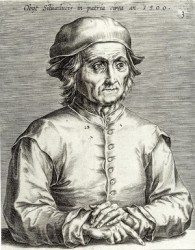
Van Baaren 1985b
“Jeroen Bosch: de interpretatie van zijn werk” (Th.P. van Baaren) 1985
[in: Tijdschrift voor Nederlands en Afrikaans, vol. 3, nr. 3 (December 1985), pp. 21-31]
A lot and very different methods have been applied to interpret the work of Bosch but up to now this has not led to a more or less general consensus. If we can detect some basic thought in a painting by Bosch, this does not automatically mean that the interpretation has to be limited to one particular method. Within the detected or suspected frame of reference divergent approaches are possible, although it stands to reason that the central perspective will remain pivotal. It seems wrong trying to harmonize all explanations with one particular method of interpretation, as Bax and Fraenger have done. Bax, who advocates a philological approach of Bosch, too often turns the painter’s works into a rebus with hardly any relation to the late-medieval spiritual climate. Many details in Bosch’s paintings have a deeper meaning but it is not necessary to look for a hidden content behind every detail. This would boil down to a denial of the artist’s imagination, as if an image could only exist by means of language and words. Fraenger, Bax’s most important antipode, and Wertheim Aymès on the other hand have come up with very unlikely interpretations reaching the most phantastic conclusions.
Van Baaren believes that in Bosch’s case the interpretation of details has to be looked for in different directions and not according to one system. Every scholar can contribute something valuable that has not been noticed by others. Sometimes Bosch paints realistic things he has seen in his environment, or proverbs and idioms, but on other occasions his symbolism seems to be derived from the Bible and the church of his days, from mysticism, from astrology or from alchemy. But the richess and originality of his imaginative powers have been pointed out far too seldom.
The objectives of the ‘Brabantine school’ whose most famous representative is father Gerlach, are to defend Bosch’s orthodoxy through thick and thin and to replace him in his direct environment. But too often these authors want to press the painter into a regional or even more local straightjacket by limiting Bosch’s world to certain popular and folkloristic elements. But alchemy and mysticism were as much part of late-medieval culture as Carnival and lay piety.
This is a sensible and intelligently written article. Van Baaren also offers concise but interesting discussions of some details of the Garden of Delights, the Haywain, the Rotterdam Pedlar and the Seven Deadly Sins panel.
[explicit 11th August2012]